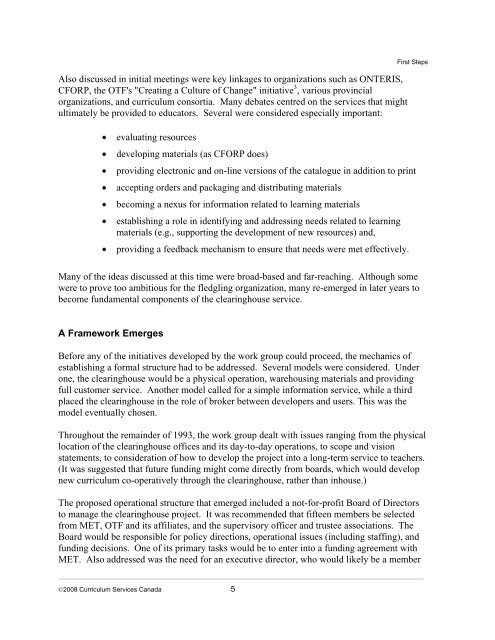a history of curriculum services canada
a history of curriculum services canada
a history of curriculum services canada
Create successful ePaper yourself
Turn your PDF publications into a flip-book with our unique Google optimized e-Paper software.
Also discussed in initial meetings were key linkages to organizations such as ONTERIS,<br />
CFORP, the OTF's "Creating a Culture <strong>of</strong> Change" initiative 3 , various provincial<br />
organizations, and <strong>curriculum</strong> consortia. Many debates centred on the <strong>services</strong> that might<br />
ultimately be provided to educators. Several were considered especially important:<br />
• evaluating resources<br />
• developing materials (as CFORP does)<br />
First Steps<br />
• providing electronic and on-line versions <strong>of</strong> the catalogue in addition to print<br />
• accepting orders and packaging and distributing materials<br />
• becoming a nexus for information related to learning materials<br />
• establishing a role in identifying and addressing needs related to learning<br />
materials (e.g., supporting the development <strong>of</strong> new resources) and,<br />
• providing a feedback mechanism to ensure that needs were met effectively.<br />
Many <strong>of</strong> the ideas discussed at this time were broad-based and far-reaching. Although some<br />
were to prove too ambitious for the fledgling organization, many re-emerged in later years to<br />
become fundamental components <strong>of</strong> the clearinghouse service.<br />
A Framework Emerges<br />
Before any <strong>of</strong> the initiatives developed by the work group could proceed, the mechanics <strong>of</strong><br />
establishing a formal structure had to be addressed. Several models were considered. Under<br />
one, the clearinghouse would be a physical operation, warehousing materials and providing<br />
full customer service. Another model called for a simple information service, while a third<br />
placed the clearinghouse in the role <strong>of</strong> broker between developers and users. This was the<br />
model eventually chosen.<br />
Throughout the remainder <strong>of</strong> 1993, the work group dealt with issues ranging from the physical<br />
location <strong>of</strong> the clearinghouse <strong>of</strong>fices and its day-to-day operations, to scope and vision<br />
statements, to consideration <strong>of</strong> how to develop the project into a long-term service to teachers.<br />
(It was suggested that future funding might come directly from boards, which would develop<br />
new <strong>curriculum</strong> co-operatively through the clearinghouse, rather than inhouse.)<br />
The proposed operational structure that emerged included a not-for-pr<strong>of</strong>it Board <strong>of</strong> Directors<br />
to manage the clearinghouse project. It was recommended that fifteen members be selected<br />
from MET, OTF and its affiliates, and the supervisory <strong>of</strong>ficer and trustee associations. The<br />
Board would be responsible for policy directions, operational issues (including staffing), and<br />
funding decisions. One <strong>of</strong> its primary tasks would be to enter into a funding agreement with<br />
MET. Also addressed was the need for an executive director, who would likely be a member<br />
©2008 Curriculum Services Canada 5
















